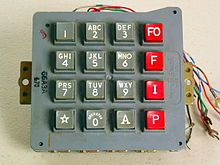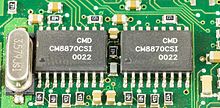DTMF

Dual-tone multi-frequency signaling (DTMF) is a
Touch-Tone dialing with a
Multifrequency signaling
Before the development of DTMF, telephone numbers were dialed by users with a loop-disconnect (LD) signaling, more commonly known as
Multi-frequency signaling (MF) is a group of signaling methods that use a mixture of two
The DTMF system uses a set of eight audio frequencies transmitted in pairs to represent 16 signals, represented by the ten digits, the letters A to D, and the symbols # and *. As the signals are audible tones in the voice frequency range, they can be transmitted through electrical repeaters and amplifiers, and over radio and microwave links, thus eliminating the need for intermediate operators on long-distance circuits.
AT&T described the product as "a method for pushbutton signaling from customer stations using the voice transmission path".
Other vendors of compatible telephone equipment called the Touch-Tone feature tone dialing or DTMF. Automatic Electric (GTE) referred to it as "Touch-calling" in their marketing. Other trade names such as Digitone were used by the
As a method of
Keypad


The DTMF telephone keypad is laid out as a matrix of push buttons in which each row represents the low frequency component and each column represents the high frequency component of the DTMF signal. The commonly used keypad has four rows and three columns, but a fourth column is present for some applications. Pressing a key sends a combination of the row and column frequencies. For example, the 1 key produces a superimposition of a 697 Hz low tone and a 1209 Hz high tone. Initial pushbutton designs employed levers, enabling each button to activate one row and one column contact. The tones are decoded by the switching center to determine the keys pressed by the user.
| 1209 Hz | 1336 Hz | 1477 Hz | 1633 Hz | |
|---|---|---|---|---|
| 697 Hz | ⓘ | ⓘ | ⓘ | ⓘ |
| 770 Hz | ⓘ | ⓘ | ⓘ | ⓘ |
| 852 Hz | ⓘ | ⓘ | ⓘ | ⓘ |
| 941 Hz | ⓘ | ⓘ | ⓘ | ⓘ |
#, *, A, B, C, and D
Engineers had envisioned telephones being used to access computers and automated response systems.[10] They consulted with companies to determine the requirements. This led to the addition of the number sign (#, ''pound'' or "diamond" in this context, "hash", "square" or "gate" in the UK, and "octothorpe'' by the original engineers) and asterisk or "star" (*) keys as well as a group of keys for menu selection: A, B, C and D. In the end, the lettered keys were dropped from most keypads and it was many years before the two symbol keys became widely used for vertical service codes such as *67 in the United States and Canada to suppress caller ID.
Public
The
Present-day uses of the signals A, B, C and D are rare in telephone networks, and are exclusive to network control. For example, A is used in some networks for cycling through a list of carriers.[citation needed] The signals are used in radio phone patch and repeater operations to allow, among other uses, control of the repeater while connected to an active telephone line.[citation needed]
The signals *, #, A, B, C and D are still widely used worldwide by amateur radio operators and commercial two-way radio systems for equipment control, repeater control, remote-base operations and some telephone communications systems.[citation needed]
DTMF signaling tones may also be heard at the start or end of some prerecorded VHS videocassettes.[12] Information on the master version of the video tape is encoded in the DTMF tones. The encoded tones provide information to automatic duplication machines, such as format, duration and volume levels in order to replicate the original video as closely as possible.
DTMF tones are used in some caller ID systems to transfer the caller ID information, a function that is performed in the United States by Bell 202 modulated frequency-shift keying (FSK) signaling.
Decoding

DTMF was originally decoded by tuned filter banks. By the end of the 20th century, digital signal processing became the predominant technology for decoding. DTMF decoding algorithms typically use the Goertzel algorithm although application of MUSIC (algorithm) to DTMF decoding has been shown to outperform Goertzel and being the only possibility in cases when number of available samples is limited.[13] As DTMF signaling is often transmitted in-band with voice or other audio signals present simultaneously, the DTMF signal definition includes strict limits for timing (minimum duration and interdigit spacing), frequency deviations, harmonics, and amplitude relation of the two components with respect to each other (twist).[14]
Other multiple frequency signals
National telephone systems define other tones, outside the DTMF specification, that indicate the status of lines, equipment, or the result of calls, and for control of equipment for troubleshooting or service purposes. Such
devices.Some early modems were based on touch-tone frequencies, such as Bell 400-style modems.[9]
See also
References
- )
- ^ Technical features of push-button telephone sets (Report). Recommendation. ITU. Q.23.
- ^ AT&T, Compatibility Bulletin No. 105
- ^ "TESS -- Error".
- ^ "DISH NETWORK L.L.C., INTERNATIONAL AFFILIATION AGREEMENT: Metro Media Holding Corp (Filer)". U.S. Securities and Exchange Commission. 27 January 2016. S.E.C. Accession No. 0001557234-16-000400. Retrieved 26 April 2020.
Cue Tones: Within four (4) months after the Launch Date, Network shall deliver the Signal with industry standard DTMF cue tones for the insertion of up to a maximum of twelve (12) minutes per hour of commercial advertising time. Until such cue tones are delivered or at any time thereafter upon DISH's request, DISH may deliver all or part of its Advertising Allocation to Network via FTP or courier, at Network's sole cost and expense, and Network shall insert such Advertising Allocation at Network's sole cost and expense.
- ^ "In the Matter of Amendment of Part 73, Subpart G, of the Commission's Rules Regarding the Emergency Broadcast System, REPORT AND ORDER AND FURTHER NOTICE OF PROPOSED RULE MAKING, B. Cable participants § 63,65" (PDF). Washington, D.C.: Federal Communications Commission. 9 December 1994. p. 23. FCC 94-288. Retrieved 26 April 2020.
Dual Tone Multi-Frequency: The Society of Cable Television Engineers (SCTE) reported that many cable systems have installed Dual Tone Multi-Frequency (DTMF) signalling equipment between the cable system and local officials for use in transmitting emergency information as part of the local franchise agreement. The SCTE recommended that DTMF decoding be incorporated in the new equipment since it is already used by many cable systems. The new EAS code protocol will be a national standard and should exceed the capabilities of DTMF. Local emergency managers will find the EAS equipment much more flexible than DTMF equipment. For example, they will be able to access EAS equipment at cable headends directly. The emergency messages in the EAS protocol will also be available to local broadcast stations and NWS offices for further dissemination.
- ^ H. Schulzrinne and T. Taylor, RTP Payload for DTMF Digits, Telephony Tones, and Telephony Signals, IETF RFC 4733, December 2006.
- ^ C. Holmberg, E. Burger, H. Kaplan, Session Initiation Protocol (SIP) INFO Method and Package Framework, IETF RFC 6086, January 2011.
- ^ a b Don Lancaster. "TV Typewriter Cookbook". (TV Typewriter). Section "400-Style (Touch-Tone) Modems". p. 177-178.
- ISBN 978-0-393-24154-9.
- ^ ""What are the ABCD tones?" — Tech FAQ". 6 April 2019.
- ^ Broadcast Engineering. Intertec Publishing Corporation], $4c 1959. 1983.
- ^ "P. Gregor, Application of MUSIC algorithm to DTMF detection, Engineering Thesis, Warsaw University of Technology, 2022".
{{cite journal}}: Cite journal requires|journal=(help) - ^ W. D. Reeves, Subscriber Loop Signaling and Transmission Handbook—Analog, IEEE (1992), p.27
- ^ AT&T, Notes on Distance Dialing, 1968
Further reading
- ITU's recommendations for implementing DTMF services
- Schenker, L (1960), "Pushbutton Calling with a Two-Group Voice-Frequency Code" (PDF), The Bell System Technical Journal, 39 (1): 235–255, (PDF) from the original on 2012-03-14.
- Deininger, R.L. (July 4, 1960). "Human Factors Engineering Studies of the Design and Use of Pushbutton Telephone Sets". Bell System Technical Journal. 39 (4): 995–1012. S2CID 265354535.
- Frank Durda, Dual Tone Multi-Frequency (Touch-Tone) Reference, 2006.
- ITU-T Recommendation Q.24 - Multifrequency push-button signal reception

